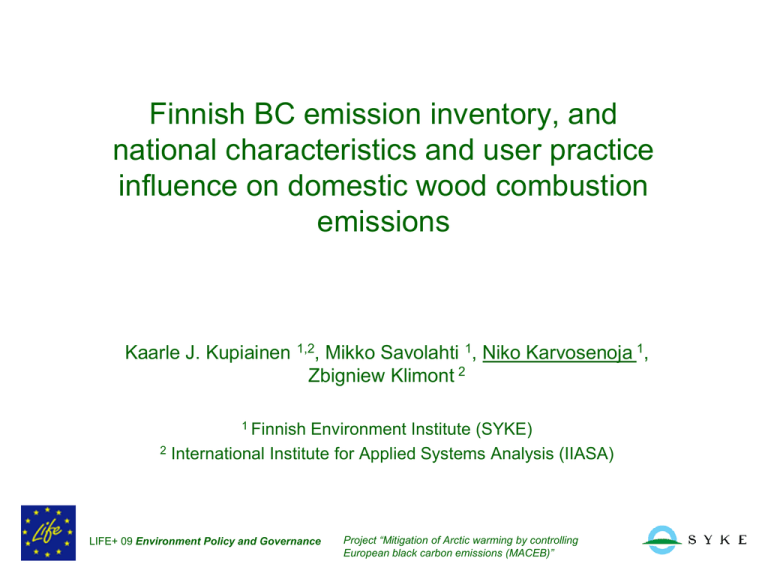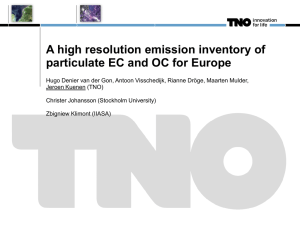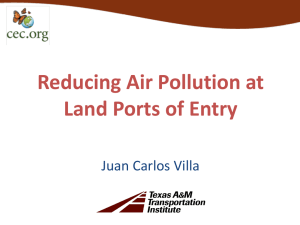Finnish BC Emissions Inventory & Comparison with Other
advertisement

Finnish BC emission inventory, and national characteristics and user practice influence on domestic wood combustion emissions Kaarle J. Kupiainen 1,2, Mikko Savolahti 1, Niko Karvosenoja 1, Zbigniew Klimont 2 1 Finnish Environment Institute (SYKE) 2 International Institute for Applied Systems Analysis (IIASA) LIFE+ 09 Environment Policy and Governance Project “Mitigation of Arctic warming by controlling European black carbon emissions (MACEB)” Content • National BC emission inventory (FRES model) • Some model results and comparisons with global and regional models • Effect of national characteristics on domestic wood combustion emissions • User practice influence on domestic wood combustion emissions – sensitivity study • Conclusions Finnish Regional Emission Scenario (FRES) model Finnish national IAM, the national tool under UNECE CLRTAP Anthropogenic emissions 1990, 2000, 2005, 2010, 2020, 2030, 2050 (several activity scenarios) Comprehensive and congruent calculation for primary and secondary PM gases •primary PM (TSP, PM10 - 2.5 - 1 - 0.1, chemical composition in size classes) •SO2, NOx, NH3, NMVOC BC OC •GHGs Abatement technologies and costs 8 main sectors, more than 100 subsectors GAINS model compatible Large point sources (approx. 250), area emissions (1 1km2) Several emission heights Source: Kupiainen et al. 2006. EMISSIONS OF PRIMARY CARBONACEOUS PARTICLES, THEIR UNCERTAINTIES AND SPATIAL ALLOCATION IN FINLAND. Proceedings of the IUAPPA Regional Conference, Lille and Paris, 5-8 September 2006 8.4.2015 www.environment.fi/syke/pm-modeling Finnish Regional Emission Scenario (FRES) model www.environment.fi/syke/pm-modeling Machinery and off-road OC Domestic wood comb., stoves Domestic wood comb., boilers 8.4.2015 Road traffic Finnish BC and OC emissions by sector • • • Transport and domestic wood combustion are key sectors BC emission reductions happen mainly in the transport sector (Euro-standards) The national climate strategy (2008) scenario assumed increasing fuel wood use and some improvements in combustion technology in the domestic sector The additional emission reduction scenario (2020red) assumes further reduction potential (-25% BC, -19% OC) – – – Domestic sector: All masonry heaters are modern (except in recreational buildings), boilers are equipped with ESPs (-8% BC, -7% OC reduction) Transport sector: All vehicles have Euro5 or Euro6 abatement (-16% BC, -9% OC reduction) Power generation & Industry: Fabric filters in large combustion plants, ESPs in small combustion plants (<50MW) (-1% BC, -3% OC reduction) 7 Other (e.g. non combustion sources) 6 Machinery, off-road, air & marine traffic 5 Road traffic 4 Industrial processes 3 2 Domestic combustion 1 0 2005 2020 Base year 2020red Power plants and industrial combustion Scenarios 6 Organic carbon Gg a-1 • Black carbon Gg a-1 8 5 Other (e.g. non combustion sources) 4 Machinery, off-road, air & marine traffic Road traffic 3 Industrial processes 2 Domestic combustion 1 0 2005 Base year 2020 2020red Scenarios Power plants and industrial combustion Comparison with other BC emission inventories 9 • Comparison with Bond et al. (2007)* BC inventory and the GAINS model** (http://gains.iiasa.ac.at) BC results shows rather good agreement Key sectors are the same in all assessments, but there are differences in total emissions as well as sectoral distribution Open burning 8 Black carbon in 2000 (Gg a-1 ) • 7 Other sources 6 Off-road 5 4 Road transport 3 2 Domestic combustion 1 0 Power plants and industry FRES Bond et al. 2004 GAINS nat GAINS IEA 9 8 * National data for Arctic Council countries presented in Sarofim et al. 2009. Current Policies, Emission Trends and Mitigation Options for Black Carbon in the Arctic Region. **GAINS model projections: • ’nat’ activities according to the national submissions within the Gothenburg protocol revision • ’IEA REF’ and ’IEA 450’ according to the International Energy Agency 2009 databases Black carbon (Gg a-1 ) 7 6 FRES 5 Bond et al. 2007 4 GAINS nat 3 GAINS IEA REF 2 GAINS IEA 450 1 0 2000 2010 2020 2030 BC and OC emission factors – national characteristics have to be reflected in emission inventories • • Dataset in 2005 (Kupiainen et al. 2006) was compiled based on international measurement literature on stoves (national BC/OC measurement were not available at the time) National measurements (field and lab) on Finnish devices became available in 20072009 (Tissari et al., 2007) and showed important differences compared with the old dataset : – – Masonry heaters and sauna stoves are most common device types in Finland (see pie chart). They are operated for a short time and with a high combustion rate. This is in contrast to e.g. iron stove or fireplace (abundant in Central Europe, US) where the need is to generate heat for a long time at low power Domestic sector activity shares for wood fuels, 2005 Boiler, automatic feed, wood pellets 1% Boiler, manual feed, no accumulator 5% Fireplace 1% Boiler, grate burning, wood chips 17% Boiler, manual feed, accumulator 15% Modern masonry heater 2% Masonry oven 12% Iron stove 2% Kitchen range 11% Conventional masonry heater 17% Sauna stove 17% Fig : Tissari et al. 2007. Atm Env 41, 8330-8344 FRES model Emissions (Gg a-1) 100 90 old 80 new 70 60 50 40 30 20 10 OC emission factors (mg MJ-1 ) 100 BC emission factors (mg MJ-1 ) Emission factors (mg MJ-1) BC and OC emission factors – national characteristics have to be reflected in emission inventories 90 old 80 new 70 60 50 40 30 20 10 0 0 Kitchen range Conventional Sauna stove masonry heater Masonry oven Modern masonry heater Kitchen range 8 8 7 7 6 6 5 Conventional Sauna stove masonry heater Masonry oven Modern masonry heater 5 Domestic wood combustion Gg BC a-1 4 3 Other sources 3 2 2 1 1 0 Domestic wood combustion Gg OC a-1 4 Other sources 0 BC with old emission factors BC with current emission factors +12% in total BC emissions, +39% in domestic wood sector BC OC with old emission factors OC with current emission factors -19% in total OC emissions, -44% in domestic wood sector OC Sensitivity study on the influence of combustion practices on small scale wood burning emissions • • • Emissions in domestic sector are influenced by combustion devices, fuel properties and user practices Studies indicate drastic increases in PM emissions from wood heaters and stoves with poor user practices No exact knowledge of the share of users with bad practices -> sensitivity study Three emission profiles were designed for input to the model to study the effect of common user mistakes in operation of residential heaters 1) 2) 3) Emissions with best operational practice of a heater Emissions with common user mistakes (not fuel related) Current emission profile was treated as average practice (composite of several devices and measurements) PM2.5 emission factor (mg MJ-1 ) • 700 (2) 600 500 400 ash 300 200 POM-OC 100 OC 0 BC mg/MJ 1) and 2) based on Tissari et al. 2008 (Atm Env 42, 7862-7873) and Frey et al. 2009 (Boreal Env Res. Vol 14, 255-271) (3) (1) Best practice emission profile mg/MJ mg/MJ Common user Current - emission mistakes profile emission profile Sensitivity study on the influence of combustion practices on small scale wood burning emissions – • – 90% of poor practice switched to best and average practice 20% of average practice is switched to best practice 60% 50% Poor combustion practice 40% Best practice of the heater 30% 5% of users make common mistakes, 35% burn according to best operational practice Emission reductions -30% in domestic wood BC -15% in total BC -47% in domestic wood OC -30% in total OC Average practice 20% 10% 0% Good combustion practice Poor combustion practice Assumed effect of an educational campaign After the campaign – • 50% of users make the common mistakes, 5% burn according to the best operational practice of the heaters Assumed effect of education campaign: – • 70% Assumed ‘Poor combustion practice’ situation: % of users • OC emissions before and after BC emissions before and after Gg a-1 9 8 7 6 5 4 3 2 1 0 Gg a-1 Before After Domestic wood combustion Before After Total emissions 10 9 8 7 6 5 4 3 2 1 0 Before After Domestic wood combustion Before After Total emissions Conclusions • • • • • • • Finnish BC emission inventory in good agreement with the GAINS model Small scale combustion in the domestic sector is a major source of BC (and OC) and it is projected to become the biggest emitter in the future. National characteristics of domestic wood combustion (e.g. influence of stove types and use patterns) should be reflected in BC inventories Emissions in domestic sector are influenced by combustion devices, fuel properties and user practices Common mistakes in user practices can lead to significantly higher PM emissions than during optimal operation Share of users making common mistakes in operating their stoves can be significant Emission reductions could be reached through non-technical measures, e.g. informing and educating people. The benefit of such measures is that the effect could be rather immediate compared to technical measures






